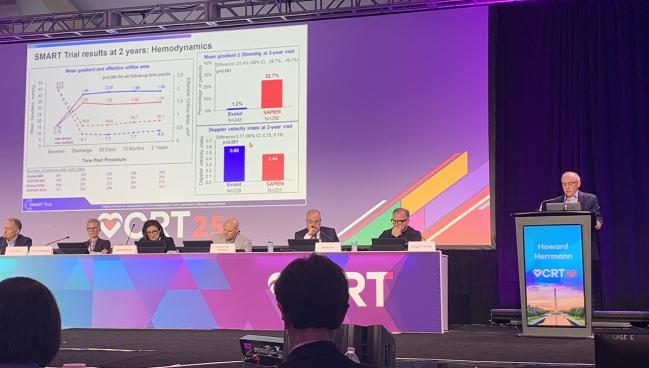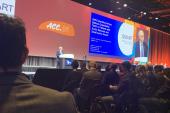SMART: Small Aortic Annuli Still Fare Best With Self-Expandable Valves at 2 Years
The data raise questions about valve hemodynamics and the role of early imaging to stay ahead of clinical and subclinical issues.

WASHINGTON, DC—Updated data from the SMART trial show that supra-annular self-expanding valves yield similar clinical outcomes as balloon-expandable valves at 2 years, but with less risk of bioprosthetic valve dysfunction, in patients with small annuli and symptomatic severe aortic stenosis.
Presenting the data here at CRT 2025, SMART lead Investigator Howard Herrmann, MD (Perelman School of Medicine at the University of Pennsylvania, Philadelphia), showed that the composite of death, disabling stroke, or heart failure rehospitalization occurred in 17.6% of the balloon-expandable group and 17.8% of the self-expanding group (HR 1.01; 95% CI 0.71-1.43).
The second co-primary endpoint of bioprosthetic valve dysfunction through 2 years favored the self-expanding valve, with a difference of 36% (P < 0.001).
The SMART investigators believe the disparity in valve hemodynamics will eventually show a clinical impact.
“I expect that we will see a difference somewhere between three and five years,” lead Herrmann told TCTMD, echoing the prediction he made when presenting the 1-year data last year. “We're seeing differences already in certain things like TIAs and subclinical leaflet thrombosis. I think there are differences between these valves that will start to show up as we go forward.”
Whether those differences will translate to increased mortality or heart failure hospitalizations is impossible to say at this point, said Herrmann, but he stressed that the body of evidence suggests that hemodynamics matter and clearly affect outcomes.
“Could one valve fail early compared to the other one? Sure. And there could be other things that influence outcomes other than hemodynamics [given that] there are competing variables for all of these outcomes,” he added. “But I do expect hemodynamics to affect outcomes over time.”
I think there are differences between these valves that will start to show up as we go forward. Howard Herrmann
Panelist Nicolas Van Mieghem, MD, PhD (Thoraxcenter, Erasmus University Medical Center, Rotterdam, the Netherlands), is not convinced, based on the data thus far, that the rate of bioprosthetic valve dysfunction with the balloon-expandable device means it’s a bad valve for this population.
“I think it's also a matter of definitions and how to interpret the definitions, and potentially there's also something to be said about how we interpret echo with the balloon-expandable and the self-expanding systems,” he said.
Megan Coylewright, MD, MPH, editor of the American College of Cardiology's CardioSmart/Patient Voice Program, said the SMART trial highlights why looking into disparities and underrepresentation in clinical trials matters. Here, in a trial with nearly 90% women, differences in how they respond to the different devices directly impacts care.
“We missed this result in our early trials, because we had such limited representation of women, just 30% in the trials. So, there really is a cost to not being inclusive,” she said.
SMART at 2 Years
SMART compared the self-expanding Evolut PRO/PRO+/FX (Medtronic) with the balloon-expandable SAPIEN 3/3 Ultra (Edwards Lifesciences) in 716 low- to intermediate-risk patients (mean age 80 years; 87% women). The mean aortic annulus area was 380.9 mm2 in the self-expanding device arm and 382.8 mm2 in the balloon-expanding device arm, with corresponding mean perimeters of 70.3 mm and 70.4 mm, respectively.
There were no differences at 2 years between the groups for the individual endpoints of mortality, cardiovascular mortality, heart failure rehospitalization, or aortic valve reintervention. Rates of new or total pacemaker implantation also were not different, nor was there any difference in rates of all stroke or disabling stroke.
Rates of TIA were 4.2% in the balloon-expandable group versus 1.2% in the self-expanding group (log-rank P = 0.02).
Should we be doing more imaging earlier and more frequently on patients with small annulus irrespective of what valve platform they have? Bruce Rutkin
Prosthetic valve thrombosis occurred in 15 patients in the balloon-expandable group and three patients in the self-expanding group (P = 0.005). Of these, 28% were late, occurring between 30 days and 1 year, and 56% were very late, occurring after 1 year. Five valve thromboses were clinically evident, attributed to two MIs, one stroke, one death, and one other emboli.
With bioprosthetic valve dysfunction, which was seen in 12.5% of the self-expanding group versus 48.4% of the balloon-expandable group, Herrmann said one in five patients in the latter arm had a mean gradient > 20 mm Hg compared with 1% in the self-expanding arm (P < 0.001). Balloon-expandable patients also were more likely to have severe prosthesis-patient mismatch through 1-year according to VARC-3 criteria (P < 0.001).
Herrmann said data from the Australian National Echo Registry of more than 6,000 patients who underwent SAVR or TAVR show that elevated mean gradient reduces survival, but don’t show an impact until about 3 years after the valve replacement. Similarly, data on prosthesis-patient mismatch suggest up to a 25% increase in mortality at 5 years, strengthening the SMART investigators’ theories that disparities between the treatment arms will eventually translate to clinical differences.
In response to a question from the panel, Herrmann said most of the subclinical leaflet thromboses were found while investigating high gradients or a change in gradients.
Future Considerations
For panelist Bruce Rutkin, MD (Northwell Health, Manhasset, NY), the trial raises issues about when and how often to be looking for early signs of dysfunction or thrombosis.
”My concern is if we're just going off of echo and waiting for an annual echo to show an increase in gradient from the previous year, it may already be too late in terms of implications of long-term durability, in terms of if we're starting to change therapy at that time,” he said. “To me, the question is, should we be doing more imaging earlier and more frequently on patients with small annulus irrespective of what valve platform they have?”
Rutkin added that given the small event rate, it's a difficult question to address at this time.
Panelist Roxana Mehran, MD (Icahn School of Medicine at Mount Sinai, New York, NY), said that—for both platforms—physicians should be looking earlier for signs of subclinical thrombosis and perhaps implementing medication changes such as switching from antiplatelets to oral anticoagulants when needed. “We've never figured out what the anticoagulation or antiplatelet regimens should be in our TAVR patients, and this might be a really good way,” she added.
Mehran reiterated that the higher incidence of bioprosthetic valve dysfunction with the balloon-expandable device, seen regardless of what definition was used, is irrefutable. “ That is what we are seeing. I know it's maybe not something we want to think about, but it really is true that that's the case,” she added.
Speaking in press conference prior to the presentation, Kimberly A. Skelding, MD (RWJBarnabas Health, Jersey City, NJ), noted that 5-year data from other trials showed an association between bioprosthetic valve dysfunction and mortality at lesser degrees than the hemodynamic changes being seen in SMART even at 2 years.
“If [balloon-expandable] valves do fail earlier, then we need to think about the lifetime management and how we put these valves into rotation . . . and what valve we're choosing as our first valve,” she said. “Those are all very important decisions.”
L.A. McKeown is a Senior Medical Journalist for TCTMD, the Section Editor of CV Team Forum, and Senior Medical…
Read Full BioSources
Herrmann HC. SMART 2-year update. Presented at: CRT 2025. March 9, 2025. Washington, DC.
Disclosures
- SMART was funded by Medtronic.
- Herrmann reports institutional grants/research support from Abbott, Affluent Medical, Caranx, and Micro Interventional Devices; and consulting for Edwards Lifesciences, Medtronic, Shockwave, and Wells Fargo.





Comments